Clinical Reasoning Report: Jonathan Yung's Case Study Analysis
VerifiedAdded on 2023/01/03
|6
|1466
|41
Report
AI Summary
This report presents a case study analysis of Jonathan Yung, a 16-year-old boy who experienced health issues after playing bubble soccer. The report, prepared by a student nurse, applies the Levett-Jones clinical reasoning cycle to assess Jonathan's condition. It begins with the collection of cues, including vital signs such as elevated temperature, high pulse and respiratory rates, and blood pressure readings. The analysis and interpretation of these cues consider Jonathan's obesity and the disruption of homeostasis. The report identifies problems like potential dehydration and the effects of the hot and humid environment. The report discusses nursing interventions related to blood pressure, breathing, and cardiac output. The document references several academic sources to support its analysis and conclusions. The report aims to demonstrate the student's ability to apply clinical reasoning to a patient scenario and propose nursing interventions.
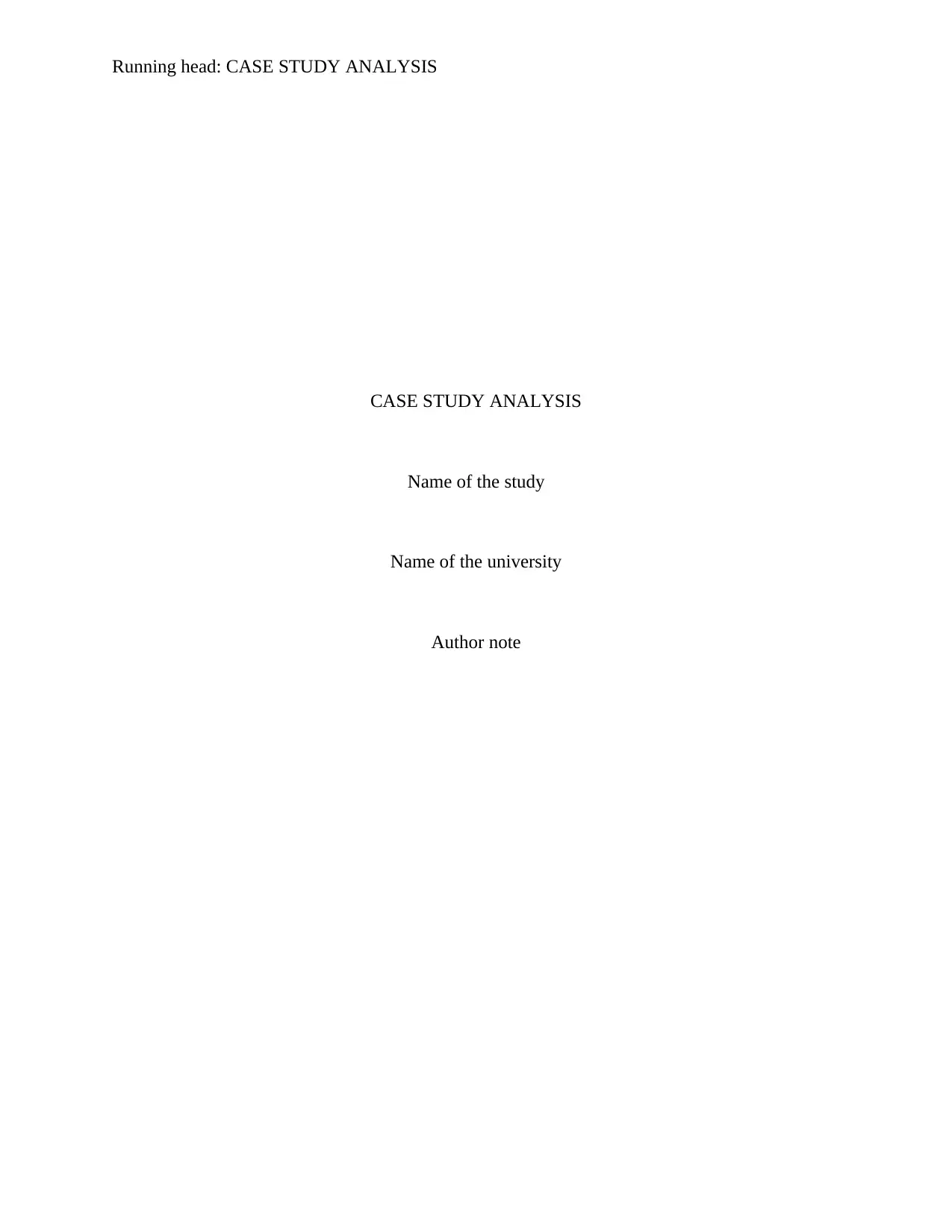
Running head: CASE STUDY ANALYSIS
CASE STUDY ANALYSIS
Name of the study
Name of the university
Author note
CASE STUDY ANALYSIS
Name of the study
Name of the university
Author note
Paraphrase This Document
Need a fresh take? Get an instant paraphrase of this document with our AI Paraphraser

1CASE STUDY ANALYSIS
Introduction
Developing care plan for a critically ill patient is a crucial responsibility for any nursing
professional as it was seen that majority of the professionals required to assess the priority of
care (Gordan, Gwathmey and Xie 2015). After this, depending on the assessment, the flow of
care, for the health improvement of the patient is determined (Marks 2015). In this assessment,
the case study of Jonathan Yung, a 16 year old boy indulged in the game of bubble cocker with
his peers would be discussed. It is mentioned that on a sunny day, he is playing bubble soccer
with his friends and the game is held in that sunny afternoon between 2 to 3 PM with 32 degree
Celsius temperature and 20% humidity. The case revolves around the fact that immediately after
the match, Jonathan develops critical situation and hence, his abnormal health condition should
be assessed.
In this scenario, by using the Levett-Jones clinical reasoning cycle, the paper would
provide a detailed reasoning of the patient’s health condition and by selected two nursing
priorities the case of Jonathan would be discussed (Dalton, Gee and Levett-Jones 2015).
Collection of cues
It was mentioned in the case scenario that Jonathan moved to this city, few months back
and hence due to this fact prior to apply healthcare interventions for his critical health condition,
his past healthcare conditions, assessment of his medical history is important. It was seen that
Jonathan is involved in bubble soccer for 1 hour consecutively and hence, it is expected that vital
signs would be developed. In the medication history it was seen that his blood pressure is low
and the reading is 111/60 however, the pulse rate is normal. With these, he has not developed
inadequate body temperature. Hence, these vital signs did not indicate towards any critical or life
Introduction
Developing care plan for a critically ill patient is a crucial responsibility for any nursing
professional as it was seen that majority of the professionals required to assess the priority of
care (Gordan, Gwathmey and Xie 2015). After this, depending on the assessment, the flow of
care, for the health improvement of the patient is determined (Marks 2015). In this assessment,
the case study of Jonathan Yung, a 16 year old boy indulged in the game of bubble cocker with
his peers would be discussed. It is mentioned that on a sunny day, he is playing bubble soccer
with his friends and the game is held in that sunny afternoon between 2 to 3 PM with 32 degree
Celsius temperature and 20% humidity. The case revolves around the fact that immediately after
the match, Jonathan develops critical situation and hence, his abnormal health condition should
be assessed.
In this scenario, by using the Levett-Jones clinical reasoning cycle, the paper would
provide a detailed reasoning of the patient’s health condition and by selected two nursing
priorities the case of Jonathan would be discussed (Dalton, Gee and Levett-Jones 2015).
Collection of cues
It was mentioned in the case scenario that Jonathan moved to this city, few months back
and hence due to this fact prior to apply healthcare interventions for his critical health condition,
his past healthcare conditions, assessment of his medical history is important. It was seen that
Jonathan is involved in bubble soccer for 1 hour consecutively and hence, it is expected that vital
signs would be developed. In the medication history it was seen that his blood pressure is low
and the reading is 111/60 however, the pulse rate is normal. With these, he has not developed
inadequate body temperature. Hence, these vital signs did not indicate towards any critical or life
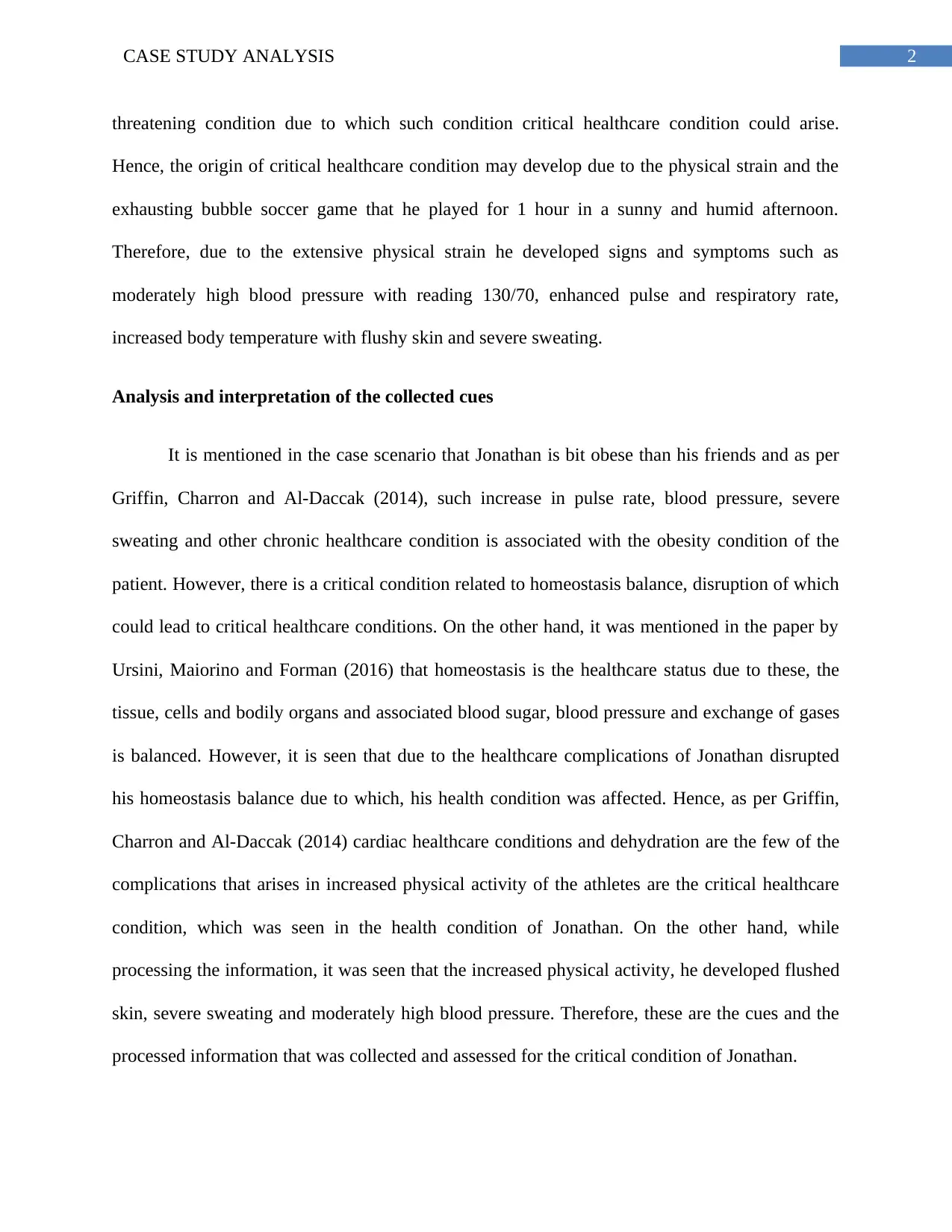
2CASE STUDY ANALYSIS
threatening condition due to which such condition critical healthcare condition could arise.
Hence, the origin of critical healthcare condition may develop due to the physical strain and the
exhausting bubble soccer game that he played for 1 hour in a sunny and humid afternoon.
Therefore, due to the extensive physical strain he developed signs and symptoms such as
moderately high blood pressure with reading 130/70, enhanced pulse and respiratory rate,
increased body temperature with flushy skin and severe sweating.
Analysis and interpretation of the collected cues
It is mentioned in the case scenario that Jonathan is bit obese than his friends and as per
Griffin, Charron and Al‐Daccak (2014), such increase in pulse rate, blood pressure, severe
sweating and other chronic healthcare condition is associated with the obesity condition of the
patient. However, there is a critical condition related to homeostasis balance, disruption of which
could lead to critical healthcare conditions. On the other hand, it was mentioned in the paper by
Ursini, Maiorino and Forman (2016) that homeostasis is the healthcare status due to these, the
tissue, cells and bodily organs and associated blood sugar, blood pressure and exchange of gases
is balanced. However, it is seen that due to the healthcare complications of Jonathan disrupted
his homeostasis balance due to which, his health condition was affected. Hence, as per Griffin,
Charron and Al‐Daccak (2014) cardiac healthcare conditions and dehydration are the few of the
complications that arises in increased physical activity of the athletes are the critical healthcare
condition, which was seen in the health condition of Jonathan. On the other hand, while
processing the information, it was seen that the increased physical activity, he developed flushed
skin, severe sweating and moderately high blood pressure. Therefore, these are the cues and the
processed information that was collected and assessed for the critical condition of Jonathan.
threatening condition due to which such condition critical healthcare condition could arise.
Hence, the origin of critical healthcare condition may develop due to the physical strain and the
exhausting bubble soccer game that he played for 1 hour in a sunny and humid afternoon.
Therefore, due to the extensive physical strain he developed signs and symptoms such as
moderately high blood pressure with reading 130/70, enhanced pulse and respiratory rate,
increased body temperature with flushy skin and severe sweating.
Analysis and interpretation of the collected cues
It is mentioned in the case scenario that Jonathan is bit obese than his friends and as per
Griffin, Charron and Al‐Daccak (2014), such increase in pulse rate, blood pressure, severe
sweating and other chronic healthcare condition is associated with the obesity condition of the
patient. However, there is a critical condition related to homeostasis balance, disruption of which
could lead to critical healthcare conditions. On the other hand, it was mentioned in the paper by
Ursini, Maiorino and Forman (2016) that homeostasis is the healthcare status due to these, the
tissue, cells and bodily organs and associated blood sugar, blood pressure and exchange of gases
is balanced. However, it is seen that due to the healthcare complications of Jonathan disrupted
his homeostasis balance due to which, his health condition was affected. Hence, as per Griffin,
Charron and Al‐Daccak (2014) cardiac healthcare conditions and dehydration are the few of the
complications that arises in increased physical activity of the athletes are the critical healthcare
condition, which was seen in the health condition of Jonathan. On the other hand, while
processing the information, it was seen that the increased physical activity, he developed flushed
skin, severe sweating and moderately high blood pressure. Therefore, these are the cues and the
processed information that was collected and assessed for the critical condition of Jonathan.
⊘ This is a preview!⊘
Do you want full access?
Subscribe today to unlock all pages.

Trusted by 1+ million students worldwide
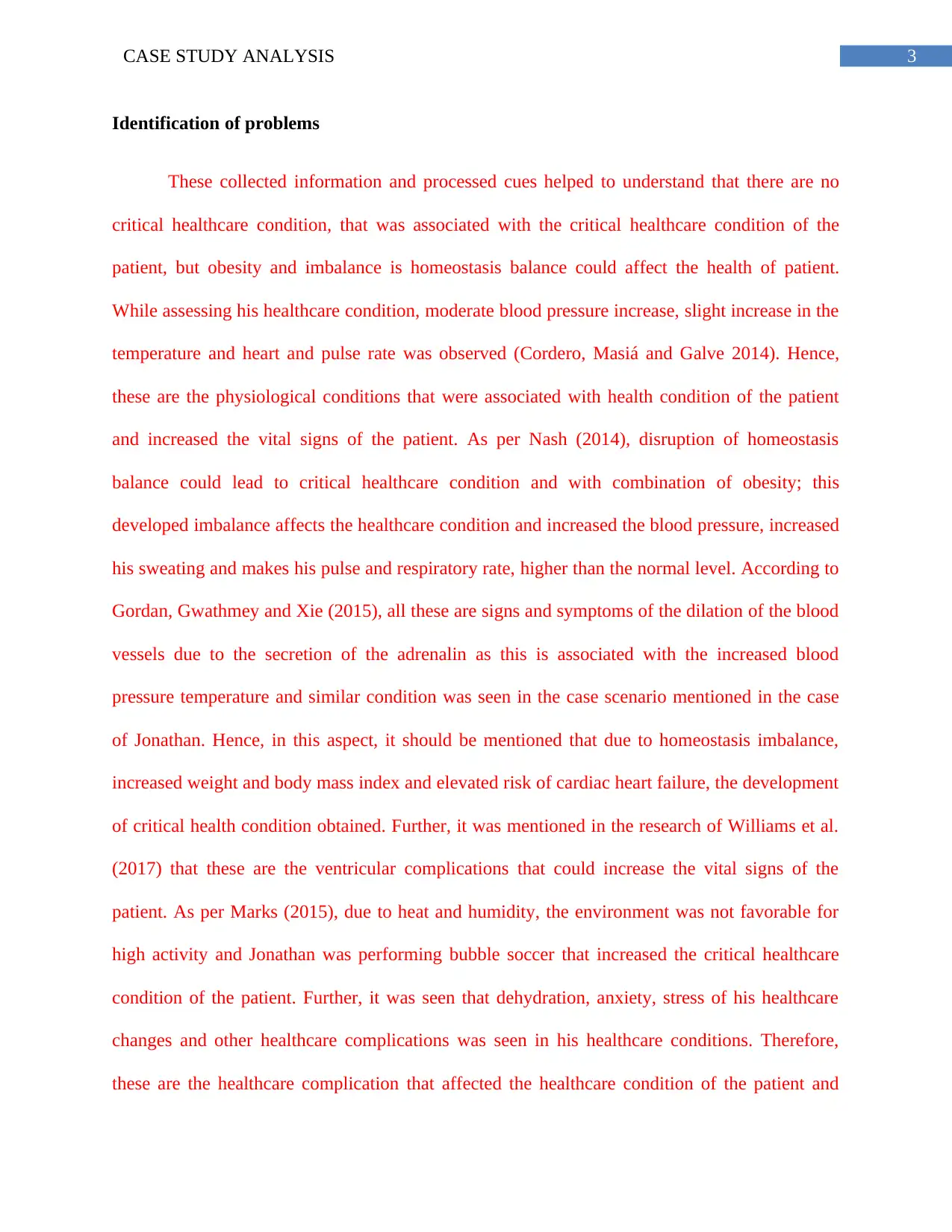
3CASE STUDY ANALYSIS
Identification of problems
These collected information and processed cues helped to understand that there are no
critical healthcare condition, that was associated with the critical healthcare condition of the
patient, but obesity and imbalance is homeostasis balance could affect the health of patient.
While assessing his healthcare condition, moderate blood pressure increase, slight increase in the
temperature and heart and pulse rate was observed (Cordero, Masiá and Galve 2014). Hence,
these are the physiological conditions that were associated with health condition of the patient
and increased the vital signs of the patient. As per Nash (2014), disruption of homeostasis
balance could lead to critical healthcare condition and with combination of obesity; this
developed imbalance affects the healthcare condition and increased the blood pressure, increased
his sweating and makes his pulse and respiratory rate, higher than the normal level. According to
Gordan, Gwathmey and Xie (2015), all these are signs and symptoms of the dilation of the blood
vessels due to the secretion of the adrenalin as this is associated with the increased blood
pressure temperature and similar condition was seen in the case scenario mentioned in the case
of Jonathan. Hence, in this aspect, it should be mentioned that due to homeostasis imbalance,
increased weight and body mass index and elevated risk of cardiac heart failure, the development
of critical health condition obtained. Further, it was mentioned in the research of Williams et al.
(2017) that these are the ventricular complications that could increase the vital signs of the
patient. As per Marks (2015), due to heat and humidity, the environment was not favorable for
high activity and Jonathan was performing bubble soccer that increased the critical healthcare
condition of the patient. Further, it was seen that dehydration, anxiety, stress of his healthcare
changes and other healthcare complications was seen in his healthcare conditions. Therefore,
these are the healthcare complication that affected the healthcare condition of the patient and
Identification of problems
These collected information and processed cues helped to understand that there are no
critical healthcare condition, that was associated with the critical healthcare condition of the
patient, but obesity and imbalance is homeostasis balance could affect the health of patient.
While assessing his healthcare condition, moderate blood pressure increase, slight increase in the
temperature and heart and pulse rate was observed (Cordero, Masiá and Galve 2014). Hence,
these are the physiological conditions that were associated with health condition of the patient
and increased the vital signs of the patient. As per Nash (2014), disruption of homeostasis
balance could lead to critical healthcare condition and with combination of obesity; this
developed imbalance affects the healthcare condition and increased the blood pressure, increased
his sweating and makes his pulse and respiratory rate, higher than the normal level. According to
Gordan, Gwathmey and Xie (2015), all these are signs and symptoms of the dilation of the blood
vessels due to the secretion of the adrenalin as this is associated with the increased blood
pressure temperature and similar condition was seen in the case scenario mentioned in the case
of Jonathan. Hence, in this aspect, it should be mentioned that due to homeostasis imbalance,
increased weight and body mass index and elevated risk of cardiac heart failure, the development
of critical health condition obtained. Further, it was mentioned in the research of Williams et al.
(2017) that these are the ventricular complications that could increase the vital signs of the
patient. As per Marks (2015), due to heat and humidity, the environment was not favorable for
high activity and Jonathan was performing bubble soccer that increased the critical healthcare
condition of the patient. Further, it was seen that dehydration, anxiety, stress of his healthcare
changes and other healthcare complications was seen in his healthcare conditions. Therefore,
these are the healthcare complication that affected the healthcare condition of the patient and
Paraphrase This Document
Need a fresh take? Get an instant paraphrase of this document with our AI Paraphraser
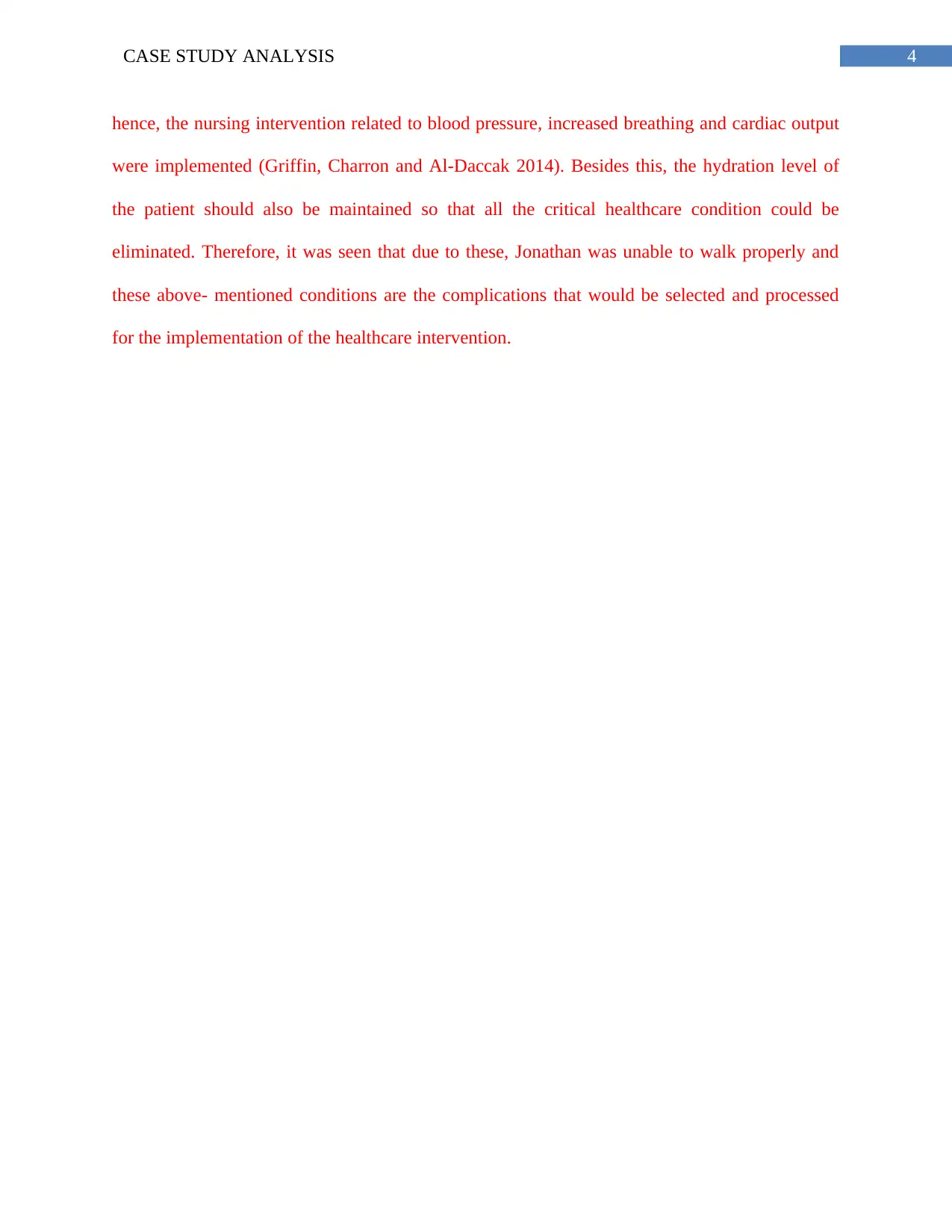
4CASE STUDY ANALYSIS
hence, the nursing intervention related to blood pressure, increased breathing and cardiac output
were implemented (Griffin, Charron and Al‐Daccak 2014). Besides this, the hydration level of
the patient should also be maintained so that all the critical healthcare condition could be
eliminated. Therefore, it was seen that due to these, Jonathan was unable to walk properly and
these above- mentioned conditions are the complications that would be selected and processed
for the implementation of the healthcare intervention.
hence, the nursing intervention related to blood pressure, increased breathing and cardiac output
were implemented (Griffin, Charron and Al‐Daccak 2014). Besides this, the hydration level of
the patient should also be maintained so that all the critical healthcare condition could be
eliminated. Therefore, it was seen that due to these, Jonathan was unable to walk properly and
these above- mentioned conditions are the complications that would be selected and processed
for the implementation of the healthcare intervention.
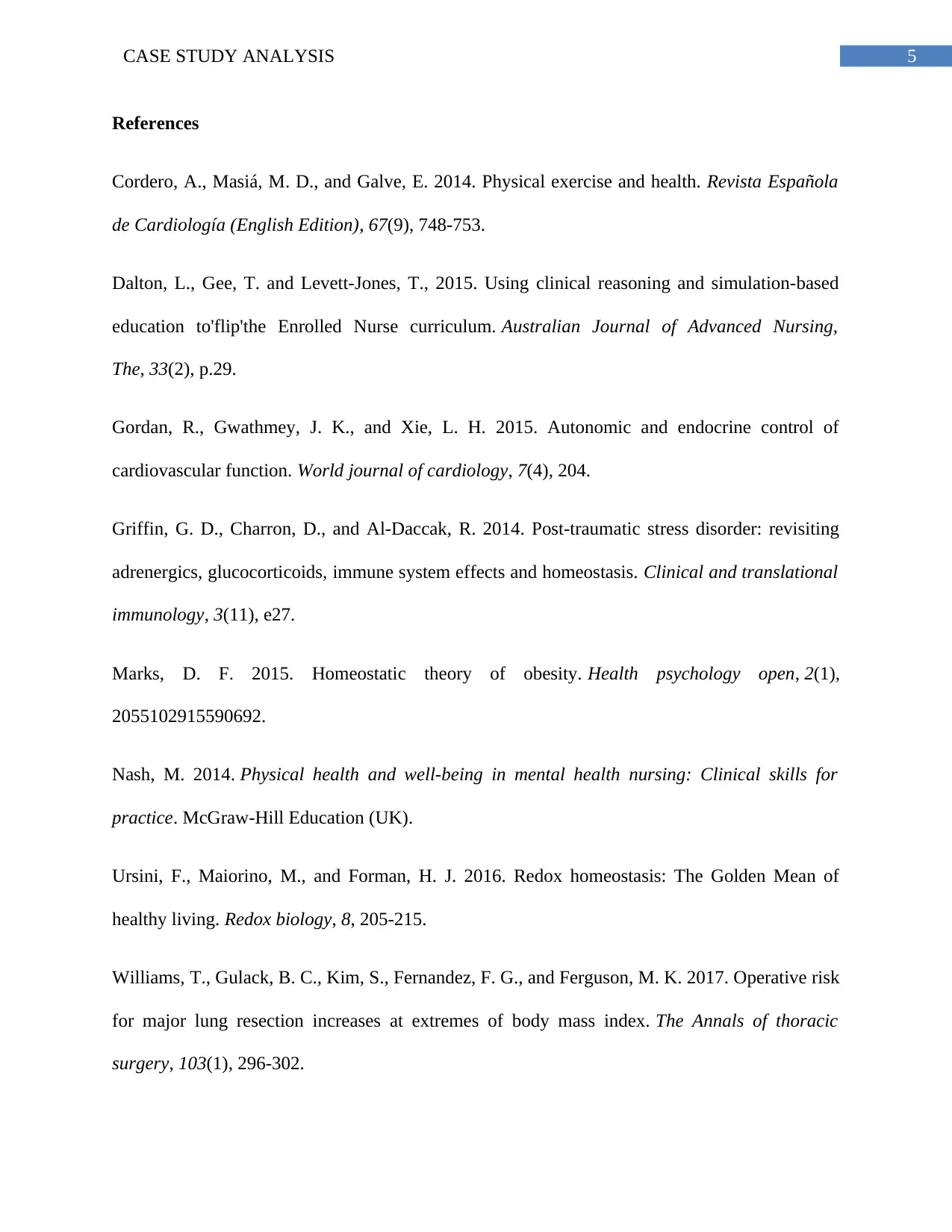
5CASE STUDY ANALYSIS
References
Cordero, A., Masiá, M. D., and Galve, E. 2014. Physical exercise and health. Revista Española
de Cardiología (English Edition), 67(9), 748-753.
Dalton, L., Gee, T. and Levett-Jones, T., 2015. Using clinical reasoning and simulation-based
education to'flip'the Enrolled Nurse curriculum. Australian Journal of Advanced Nursing,
The, 33(2), p.29.
Gordan, R., Gwathmey, J. K., and Xie, L. H. 2015. Autonomic and endocrine control of
cardiovascular function. World journal of cardiology, 7(4), 204.
Griffin, G. D., Charron, D., and Al‐Daccak, R. 2014. Post‐traumatic stress disorder: revisiting
adrenergics, glucocorticoids, immune system effects and homeostasis. Clinical and translational
immunology, 3(11), e27.
Marks, D. F. 2015. Homeostatic theory of obesity. Health psychology open, 2(1),
2055102915590692.
Nash, M. 2014. Physical health and well-being in mental health nursing: Clinical skills for
practice. McGraw-Hill Education (UK).
Ursini, F., Maiorino, M., and Forman, H. J. 2016. Redox homeostasis: The Golden Mean of
healthy living. Redox biology, 8, 205-215.
Williams, T., Gulack, B. C., Kim, S., Fernandez, F. G., and Ferguson, M. K. 2017. Operative risk
for major lung resection increases at extremes of body mass index. The Annals of thoracic
surgery, 103(1), 296-302.
References
Cordero, A., Masiá, M. D., and Galve, E. 2014. Physical exercise and health. Revista Española
de Cardiología (English Edition), 67(9), 748-753.
Dalton, L., Gee, T. and Levett-Jones, T., 2015. Using clinical reasoning and simulation-based
education to'flip'the Enrolled Nurse curriculum. Australian Journal of Advanced Nursing,
The, 33(2), p.29.
Gordan, R., Gwathmey, J. K., and Xie, L. H. 2015. Autonomic and endocrine control of
cardiovascular function. World journal of cardiology, 7(4), 204.
Griffin, G. D., Charron, D., and Al‐Daccak, R. 2014. Post‐traumatic stress disorder: revisiting
adrenergics, glucocorticoids, immune system effects and homeostasis. Clinical and translational
immunology, 3(11), e27.
Marks, D. F. 2015. Homeostatic theory of obesity. Health psychology open, 2(1),
2055102915590692.
Nash, M. 2014. Physical health and well-being in mental health nursing: Clinical skills for
practice. McGraw-Hill Education (UK).
Ursini, F., Maiorino, M., and Forman, H. J. 2016. Redox homeostasis: The Golden Mean of
healthy living. Redox biology, 8, 205-215.
Williams, T., Gulack, B. C., Kim, S., Fernandez, F. G., and Ferguson, M. K. 2017. Operative risk
for major lung resection increases at extremes of body mass index. The Annals of thoracic
surgery, 103(1), 296-302.
⊘ This is a preview!⊘
Do you want full access?
Subscribe today to unlock all pages.

Trusted by 1+ million students worldwide
1 out of 6
Related Documents
Your All-in-One AI-Powered Toolkit for Academic Success.
+13062052269
info@desklib.com
Available 24*7 on WhatsApp / Email
![[object Object]](/_next/static/media/star-bottom.7253800d.svg)
Unlock your academic potential
Copyright © 2020–2025 A2Z Services. All Rights Reserved. Developed and managed by ZUCOL.





